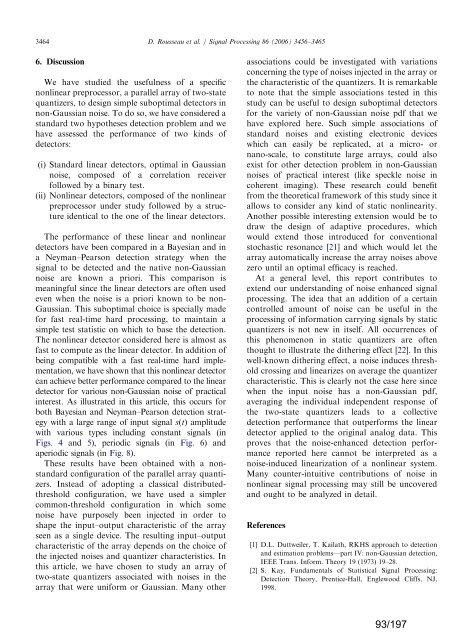a la physique de l'information - Lisa - Université d'Angers
a la physique de l'information - Lisa - Université d'Angers
a la physique de l'information - Lisa - Université d'Angers
Create successful ePaper yourself
Turn your PDF publications into a flip-book with our unique Google optimized e-Paper software.
3464<br />
6. Discussion<br />
We have studied the usefulness of a specific<br />
nonlinear preprocessor, a parallel array of two-state<br />
quantizers, to <strong>de</strong>sign simple suboptimal <strong>de</strong>tectors in<br />
non-Gaussian noise. To do so, we have consi<strong>de</strong>red a<br />
standard two hypotheses <strong>de</strong>tection problem and we<br />
have assessed the performance of two kinds of<br />
<strong>de</strong>tectors:<br />
(i) Standard linear <strong>de</strong>tectors, optimal in Gaussian<br />
noise, composed of a corre<strong>la</strong>tion receiver<br />
followed by a binary test.<br />
(ii) Nonlinear <strong>de</strong>tectors, composed of the nonlinear<br />
preprocessor un<strong>de</strong>r study followed by a structure<br />
i<strong>de</strong>ntical to the one of the linear <strong>de</strong>tectors.<br />
The performance of these linear and nonlinear<br />
<strong>de</strong>tectors have been compared in a Bayesian and in<br />
a Neyman–Pearson <strong>de</strong>tection strategy when the<br />
signal to be <strong>de</strong>tected and the native non-Gaussian<br />
noise are known a priori. This comparison is<br />
meaningful since the linear <strong>de</strong>tectors are often used<br />
even when the noise is a priori known to be non-<br />
Gaussian. This suboptimal choice is specially ma<strong>de</strong><br />
for fast real-time hard processing, to maintain a<br />
simple test statistic on which to base the <strong>de</strong>tection.<br />
The nonlinear <strong>de</strong>tector consi<strong>de</strong>red here is almost as<br />
fast to compute as the linear <strong>de</strong>tector. In addition of<br />
being compatible with a fast real-time hard implementation,<br />
we have shown that this nonlinear <strong>de</strong>tector<br />
can achieve better performance compared to the linear<br />
<strong>de</strong>tector for various non-Gaussian noise of practical<br />
interest. As illustrated in this article, this occurs for<br />
both Bayesian and Neyman–Pearson <strong>de</strong>tection strategy<br />
with a <strong>la</strong>rge range of input signal sðtÞ amplitu<strong>de</strong><br />
with various types including constant signals (in<br />
Figs. 4 and 5), periodic signals (in Fig. 6) and<br />
aperiodic signals (in Fig. 8).<br />
These results have been obtained with a nonstandard<br />
configuration of the parallel array quantizers.<br />
Instead of adopting a c<strong>la</strong>ssical distributedthreshold<br />
configuration, we have used a simpler<br />
common-threshold configuration in which some<br />
noise have purposely been injected in or<strong>de</strong>r to<br />
shape the input–output characteristic of the array<br />
seen as a single <strong>de</strong>vice. The resulting input–output<br />
characteristic of the array <strong>de</strong>pends on the choice of<br />
the injected noises and quantizer characteristics. In<br />
this article, we have chosen to study an array of<br />
two-state quantizers associated with noises in the<br />
array that were uniform or Gaussian. Many other<br />
ARTICLE IN PRESS<br />
D. Rousseau et al. / Signal Processing 86 (2006) 3456–3465<br />
associations could be investigated with variations<br />
concerning the type of noises injected in the array or<br />
the characteristic of the quantizers. It is remarkable<br />
to note that the simple associations tested in this<br />
study can be useful to <strong>de</strong>sign suboptimal <strong>de</strong>tectors<br />
for the variety of non-Gaussian noise pdf that we<br />
have explored here. Such simple associations of<br />
standard noises and existing electronic <strong>de</strong>vices<br />
which can easily be replicated, at a micro- or<br />
nano-scale, to constitute <strong>la</strong>rge arrays, could also<br />
exist for other <strong>de</strong>tection problem in non-Gaussian<br />
noises of practical interest (like speckle noise in<br />
coherent imaging). These research could benefit<br />
from the theoretical framework of this study since it<br />
allows to consi<strong>de</strong>r any kind of static nonlinearity.<br />
Another possible interesting extension would be to<br />
draw the <strong>de</strong>sign of adaptive procedures, which<br />
would extend those introduced for conventional<br />
stochastic resonance [21] and which would let the<br />
array automatically increase the array noises above<br />
zero until an optimal efficacy is reached.<br />
At a general level, this report contributes to<br />
extend our un<strong>de</strong>rstanding of noise enhanced signal<br />
processing. The i<strong>de</strong>a that an addition of a certain<br />
controlled amount of noise can be useful in the<br />
processing of information carrying signals by static<br />
quantizers is not new in itself. All occurrences of<br />
this phenomenon in static quantizers are often<br />
thought to illustrate the dithering effect [22]. In this<br />
well-known dithering effect, a noise induces threshold<br />
crossing and linearizes on average the quantizer<br />
characteristic. This is clearly not the case here since<br />
when the input noise has a non-Gaussian pdf,<br />
averaging the individual in<strong>de</strong>pen<strong>de</strong>nt response of<br />
the two-state quantizers leads to a collective<br />
<strong>de</strong>tection performance that outperforms the linear<br />
<strong>de</strong>tector applied to the original analog data. This<br />
proves that the noise-enhanced <strong>de</strong>tection performance<br />
reported here cannot be interpreted as a<br />
noise-induced linearization of a nonlinear system.<br />
Many counter-intuitive contributions of noise in<br />
nonlinear signal processing may still be uncovered<br />
and ought to be analyzed in <strong>de</strong>tail.<br />
References<br />
[1] D.L. Duttweiler, T. Kai<strong>la</strong>th, RKHS approach to <strong>de</strong>tection<br />
and estimation problems—part IV: non-Gaussian <strong>de</strong>tection,<br />
IEEE Trans. Inform. Theory 19 (1973) 19–28.<br />
[2] S. Kay, Fundamentals of Statistical Signal Processing:<br />
Detection Theory, Prentice-Hall, Englewood Cliffs, NJ,<br />
1998.<br />
93/197


